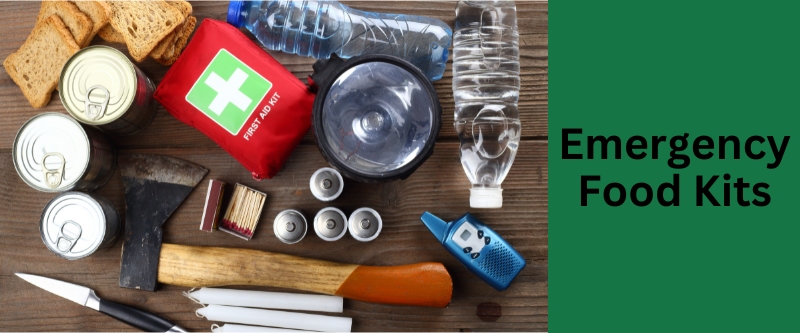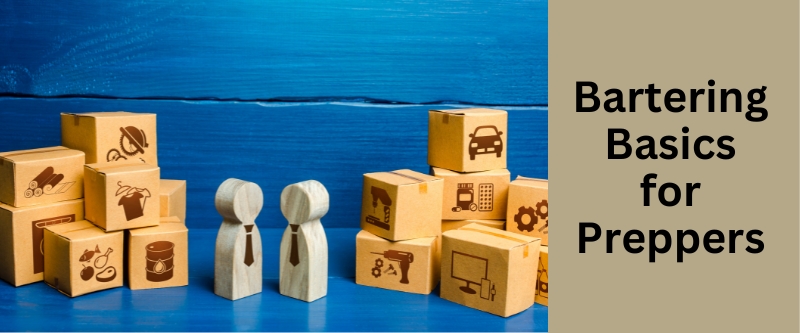Table of Contents
Introduction
In today’s unpredictable world, being prepared for unforeseen circumstances is more crucial than ever. Whether it’s a natural disaster, a power outage, or any other emergency, having a reliable source of nutrition can make all the difference. Enter the Emergency Food Kit.
Not to be confused with your regular pantry stockpile, these kits are specially designed to provide sustenance in dire situations. So, let’s dive into the world of emergency food kits and understand their pivotal role in prepper planning.
Understanding the Basics
Emergency Food Kits are not just about having extra cans of beans or bags of rice. They’re about having a well-thought-out plan for nutrition that can sustain you and your loved ones when regular food sources are unavailable.
- What is an emergency food kit? At its core, an emergency food kit is a collection of non-perishable, long-lasting, and nutritionally balanced food items specifically curated for emergency scenarios. These kits often include freeze-dried meals, hydration supplements, and even emergency food ration bars.
- Why every household should consider having one: No one anticipates emergencies, but they do happen. From hurricanes to earthquakes, natural disasters can strike without warning. And then you have the less predictable but nonetheless foreseeable possibilities of civil unrest or war. So having an emergency food kit ensures that you have a reliable food source, even when grocery stores are inaccessible or empty.
Regular Food Storage vs Food Kits
While both regular food storage and emergency food kits play a role in preparedness, they serve different purposes:
- Regular Food Storage: This is the food you consume daily. It includes perishables like fruits and vegetables, as well as non-perishables like grains and canned goods. Regular food storage is essential for day-to-day living but may not be sufficient in a prolonged emergency.
- Emergency Food Kits: These are specially designed for long-term storage and are packed with calorie-dense options to provide energy in crisis situations. They often require minimal preparation – just add hot or cold water, and you have a meal ready.
- The Ideal Proportion: Balancing regular food storage with emergency kits is key. A good rule of thumb is to have enough regular food to last a week and an emergency food kit that can sustain your household for at least 72 hours to a month, depending on the size of your family and your preparedness goals.
- Benefits of Having Both: While regular food storage offers variety and freshness, emergency food kits provide longevity and security. Together, they ensure you’re prepared for both short-term and long-term disruptions.
Long Term Food Storage – A Balance
In the area of long-term food storage, striking the right balance between freeze-dried foods and regular food staples is crucial.
Freeze Dried Food
Freeze-dried foods offer the advantage of extended shelf life, often up to 25-30 years, and retain most of their nutritional value, making them an excellent choice for situations where food availability might be scarce.
They’re lightweight, easy to store, and can be rehydrated quickly, providing a near-instant meal. This makes them particularly valuable for situations where cooking might be challenging or where water is available but other resources are limited.
Regular Food Staples
On the other hand, regular food staples, such as grains, beans, and canned goods, are often more cost-effective and can form the backbone of your long-term storage plan. These items provide essential carbohydrates, proteins, and fats, and when stored properly, can last for several years. In fact grains and beans, when stored properly, can last for many years, just as long as freeze-dried food.
They’re familiar, versatile, and can be used in a variety of recipes, ensuring that meals remain varied and satisfying. However, they often require more preparation and may rely on a stable water and energy source for cooking.
Combination
In essence, while freeze-dried foods offer convenience and longevity, regular staples provide familiarity and cost-effectiveness. For a well-rounded long-term food storage plan, a combination of both, tailored to individual needs and circumstances, is the ideal approach.
Types of Emergency Food Kits
When it comes to Emergency Food Kits, there’s no one-size-fits-all. Depending on your needs, budget, and dietary restrictions, you can choose from a variety of options:
- Freeze-dried meals: These are among the most popular choices for survival food kits. They’re lightweight, have a long shelf life, and retain most of their original nutrients and flavors. Just add water, and you have a meal that tastes good and is ready in minutes.
- Canned goods: While heavier than freeze-dried options, canned goods like vegetables, fruits, and meats can be a valuable addition to your emergency stash. They offer a good variety and can be consumed directly from the can.
- DIY kits: For those who prefer a personalized touch, creating your own emergency food kit can be both fun and rewarding. This allows you to handpick each item, ensuring it aligns with your tastes and dietary needs.
- Specialized kits for dietary needs: Today, many companies offer emergency food kits tailored for specific dietary restrictions. Whether you’re looking for gluten-free, soy-free, or organic options, there’s likely a kit out there for you.
Freeze Dried Food – Central to All Kits
Introduction to Freeze-Drying
Freeze-drying, also known as lyophilization, is a method of preserving food that has been around for over a century. It’s a process that removes the moisture from food, allowing it to be stored for extended periods without refrigeration. This makes it a staple in emergency food kits, where longevity and nutrient retention are paramount. It also provides a degree of comfort in troubled times, since it comes in the form of familar food.
The Freeze-Drying Process
Freezing
The food is rapidly frozen, typically at temperatures below -30°C. This rapid freezing locks in the nutrition and flavor, ensuring the food’s integrity is maintained.
Vacuum and Low Heat
The frozen food is then placed in a vacuum chamber, and a small amount of heat is applied. This environment allows the ice within the food to vaporize without ever passing through a liquid phase.
Sublimation
This is the magic of freeze-drying. In the vacuum chamber, the ice directly converts into vapor, a process known as sublimation. This leaves behind the structure of the food, but without the water content.
Sealing
Once the moisture is entirely removed, the food is sealed in moisture and oxygen-proof packaging. This packaging often includes an oxygen absorber to ensure the environment inside remains stable.
Benefits of Freeze-Dried Food
Long Shelf Life
One of the standout benefits of freeze-dried food is its incredibly long shelf life. Some products can last up to 25 years or more when stored correctly. This longevity is due to the removal of moisture, preventing microbial growth.
Nutritional Integrity
Unlike other preservation methods, freeze-drying retains most of the food’s original nutrients. Vitamins, minerals, and other essential compounds remain intact, ensuring you get a nutritious meal when it’s rehydrated.
Lightweight
Without its water content, freeze-dried food is incredibly lightweight. This makes it a favorite for bug-out bags and portable emergency kits.
Taste and Texture
Upon rehydration, freeze-dried food regains much of its original flavor and texture. This means you’re not just eating for survival; you’re enjoying your meal too!
Why Freeze-Dried Food Lasts So Long
Absence of Moisture
Microorganisms, the culprits behind food spoilage, require water to grow. By removing the moisture, freeze-drying effectively halts microbial activity.
Oxygen-Free Packaging
Oxygen can degrade food over time. The oxygen-free packaging ensures that the food remains in a stable state for years.
Stable Environment
The sealed packaging protects the food from external factors like light and humidity, further extending its shelf life.
Rehydrating and Consuming Freeze-Dried Food
Rehydrating freeze-dried food is a breeze. Simply add water, wait a few minutes, and your meal is ready. For best results, use hot water to restore the food’s original texture and flavor. However, in a pinch, cold water will work too.
Popular Freeze-Dried Foods in Emergency Kits
From fruits like strawberries and apples to full meals like beef stew or chicken risotto, the options are vast. The versatility of freeze-dried food means there’s something for every palate, even in an emergency.
Considerations When Buying Freeze-Dried Food
Always check expiration dates and consider any dietary restrictions or preferences you might have. It’s also wise to research the brand or manufacturer to ensure you’re getting a quality product.
Factors to Consider in Choosing a Kit
Selecting the right emergency food kit is crucial. Here are some factors to keep in mind:
- Shelf life: Ideally, you’d want a kit that lasts for years, if not decades. Look for options with a long shelf life to ensure your food remains fresh and safe to eat when you need it.
- Nutritional value: In emergency situations, your body needs all the energy it can get. Opt for kits that offer a balanced mix of proteins, fats, and carbohydrates.
- Portion sizes: Ensure the kit provides adequate servings for your family. Some kits might seem large, but if they don’t offer enough servings, they won’t be of much use.
- Taste and variety: While nutrition is paramount, you also want food that tastes good. Look for kits that offer a good variety of meals to prevent palate fatigue.
Storing Your Emergency Food Kits
Once you’ve got your hands on the perfect Emergency Food Kit, the next step is ensuring it’s stored correctly. Proper storage not only prolongs the shelf life of your food but also ensures it remains safe to consume.
- Cool and Dry Place: Heat can degrade the quality of your food over time. Store your kits in a cool, dry place, away from direct sunlight. Basements or cellars are often ideal, but if you don’t have one, a dark closet will do.
- Away from Pests: Mice, rats, and even bugs can be a menace. Ensure your food is stored in pest-proof containers or shelves. Regularly inspect the area for any signs of infestations.
- Rotate Your Stock: Even long-lasting emergency food has an expiration date. Make it a habit to check the expiry dates and rotate your stock. Consume the older items and replace them with fresh stock.
- Seal it Up: If your kit isn’t already vacuum-sealed, consider storing it in airtight containers. This prevents moisture and air from degrading the quality of your food.
The Importance of Water
While food is essential, water is even more so. In many emergency situations, access to clean drinking water can become a challenge.
- Water Supplies: Alongside your food kit, ensure you have enough water stored. FEMA recommends a gallon per person per day for at least three days.
- Water Purification: In situations where you’re unsure of the water’s purity, having a means to disinfect it is crucial. Consider adding water purification tablets or a portable water filter to your emergency supplies.
- Hydration Supplements: Some emergency food kits come with hydration supplements. These can be invaluable in situations where water is scarce, helping your body stay hydrated and function optimally. If the kit does not come with hydration supplements, you can get them separately. And it’s a good idea to have them on hand anyway.
Essentials to Accompany Your Food Kit
Having an Emergency Food Kit is just one part of the equation. To make the most of it, you’ll need some essential equipment on hand:
- Portable Stove or Heater: Many freeze-dried meals require hot water to prepare. A portable stove can be invaluable, especially if there’s a power outage. Don’t forget to stock up on fuel too!
- Durable Utensils: Think beyond plastic spoons and forks. Invest in a set of durable, reusable utensils that can withstand the rigors of emergency situations.
- Can Opener: If your kit includes canned goods, a reliable can opener is a must. The last thing you want is to be unable to access your food when you need it most.
- Sealable Bags or Containers: Once you open a package, you might not consume all of it. Having sealable bags or containers helps store leftovers safely.
Bug-Out Food Kit
In the unpredictable world of emergencies, having a bug-out food kit is essential for those moments when you need to evacuate swiftly. A well-prepared bug-out food kit should prioritize portability, nutrition, and ease of preparation.
Given the nature of a bug-out scenario, where time and resources might be limited, freeze-dried meals are a top choice. These meals are lightweight, compact, and can be prepared with just water, making them perfect for on-the-go situations. They come in a variety of options, from hearty stews to pasta dishes, ensuring you get a mix of proteins, carbohydrates, and essential vitamins.
However, a comprehensive bug-out food kit shouldn’t rely solely on freeze-dried meals. Incorporate energy-dense snacks like protein bars, nuts, and dried fruits to keep energy levels up without the need for preparation. Don’t forget essentials like a portable water filter or purification tablets, as clean water is crucial not just for hydration but for preparing your meals.
Lastly, consider the duration of your kit. A standard recommendation is a 72-hour supply, but based on individual needs and potential scenarios, you might opt for a longer duration. Remember, in a bug-out situation, your food kit should provide sustenance and energy without weighing you down, so choose items that offer maximum nutrition with minimum fuss.
You can put this in your bug-out bag:
Beyond Food: Other Essentials for Preparedness
While food and water are vital, true preparedness goes beyond just sustenance, whether you are bugging-out or hunkered down:
- First Aid Kit: Injuries can happen, especially in emergencies. A comprehensive first aid kit ensures you can address minor injuries promptly.
- Lighting: Power outages are common in many emergency scenarios. Flashlights, lanterns, and even glow sticks can make a world of difference.
- Communication Devices: Keeping informed is crucial. Battery-operated radios or even satellite phones can help you stay updated on the situation.
- Protection: Depending on the nature of the emergency, having a means to protect yourself and your loved ones might be necessary. This could range from pepper sprays to more advanced protective gear, including firearms.
Conclusion
In an ever-changing world, being prepared is not just a choice but a necessity. Emergency Food Kits play a pivotal role in ensuring you and your loved ones have the sustenance needed to weather any storm. But remember, true preparedness is holistic. It’s about having the right food, the right equipment, and the right mindset. Stay safe, stay prepared!
FAQs
What exactly is an Emergency Food Kit?
An Emergency Food Kit is a collection of non-perishable food items specifically designed to sustain individuals during emergencies when regular food sources might be unavailable.
How long do these food kits last?
While the shelf life varies by product, many kits are designed to last for years, if not decades. Always check the expiration date and store them properly to maximize their lifespan.
Can I customize my own food kit?
Absolutely! While there are many pre-made options available, you can also create a DIY kit tailored to your preferences and dietary needs.
How much water should I store alongside my food kit?
FEMA recommends storing at least one gallon of water per person per day for a minimum of three days.
Are there gluten-free or organic emergency food options?
Yes, many companies now offer specialized kits catering to various dietary restrictions, including gluten-free, soy-free, and organic options.
How do I prepare freeze-dried meals from the kit?
Most freeze-dried meals require you to add hot water and wait a few minutes. Always follow the instructions on the package.
What other equipment should I have with my food kit?
Consider having a portable stove, durable utensils, a can opener, and sealable containers or bags. These can enhance your emergency food preparation experience.
What is freeze-drying?
Freeze-drying is a process that removes moisture from food by freezing it and then reducing the surrounding pressure to allow the frozen water in the food to sublimate directly from the solid phase to the gas phase.
How long does freeze-dried food last?
When stored properly in a sealed container or pouch, freeze-dried food can last up to 25-30 years. The shelf life can vary based on the type of food and storage conditions.
Does freeze-drying preserve the nutritional value of food?
Yes, freeze-drying preserves most of the vitamins and minerals in food. Because it involves low temperatures, it retains more nutrients compared to other preservation methods like canning or dehydrating.
Can you freeze-dry any type of food?
While most foods can be freeze-dried, some foods with high water content, like watermelon, don’t retain their original structure after freeze-drying. However, they can still be consumed in their freeze-dried state.
How do you rehydrate freeze-dried foods?
To rehydrate freeze-dried foods, simply add water. Warm water will speed up the rehydration process, but cold water can also be used.
Is freeze-dried food the same as dehydrated food?
No, while both processes remove moisture from food, freeze-drying involves freezing the food and then drying it, whereas dehydration involves heating food to remove moisture.
Why is freeze-dried food more expensive?
The freeze-drying process requires specialized equipment and is more energy-intensive than other drying methods, making it more expensive. However, the extended shelf life and preserved nutritional value can make it a cost-effective choice in the long run.
Can I freeze-dry food at home?
Yes, there are home freeze dryers available on the market. While they can be an investment upfront, they allow you to preserve your own food for long-term storage.
Does freeze-drying kill bacteria?
While freeze-drying doesn’t kill bacteria or pathogens, it makes them dormant by removing the moisture they need to grow. It’s always a good idea to cook rehydrated food to ensure any potential bacteria are killed.What are the most popular freeze-dried foods?
Fruits, vegetables, meats, and full meals are popular choices for freeze-drying. They retain their flavor and nutritional value, making them a favorite for backpackers, campers, and preppers.








Leave a Reply